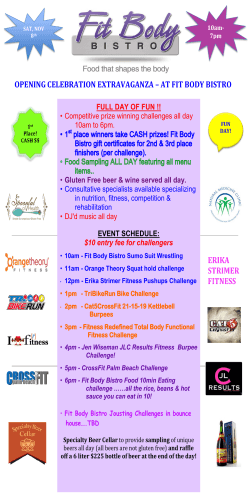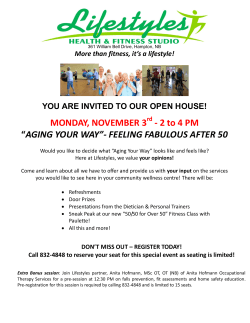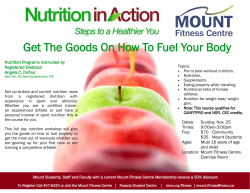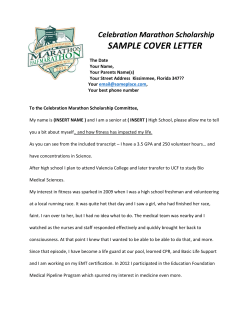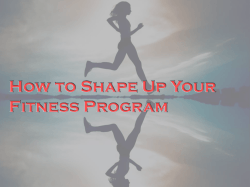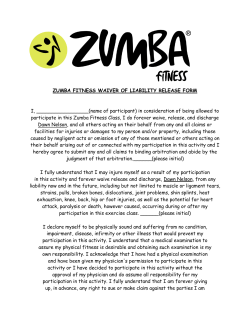
P A HYSIOLOGY OF HYSICAL
PHYSIOLOGY OF PHYSICAL ACTIVITY KNR 164 PHYSIOLOGY OF PHYSICAL ACTIVITY Often called: Exercise Science or Exercise Physiology Principles of biology and chemistry are used to understand how the body responds to PA Key features of this subdiscipline: Understanding how the body responds to meet immediate (acute) demands of being PA How the body adapts to repeated (chronic) bouts of PA GOALS OF EXERCISE PHYSIOLOGY 1. to understand how to enhance PA 2. to understand how to improve physical function in particular environments 3. to understand how PA and exercise improve health and fitness 4. to understand how exercise can be used in treating and preventing disease and alleviating symptoms of disease 5. to understand adaptations in human anatomy and physiology in response to PA WHAT CAN YOU DO AS AN EXERCISE PHYSIOLOGIST? Help athletes perform at peak levels Help people understand how to safely participate in PA Conduct research to help prevent and treat disease through PA and exercise Help people overcome environmental factors (i.e. temperature, altitude) during PA to maximize their work capacity AREAS OF EMPLOYMENT Fitness or wellness center Hospital Corporation Academic institution Research laboratory Exercise instructors (commercial/corporate) Personal trainers Strength and conditioning coach Clinical areas (cardiac/pulmonary rehabilitation) Military National Aeronautics and Space Administration (NASA) CERTIFICATIONS OF INTEREST American College of Sports Medicine (ACSM) National Strength and Conditioning Association (NSCA) Aerobics and Fitness Association of America (AFAA) American Council on Exercise (ACE) Term Exercise Physiologist generally reserved for those with a master’s degree **depending on area, other certification may be required** ENHANCE SPORT PERFORMANCE & TRAINING Application of physiological techniques to understand and improve Sport Physiology: the concepts of exercise physiology to training the athlete and enhancing the athlete’s sport performance (Wilmore & Costill, 1994) Impact of stretching on sport performance Effects of dehydration on wrestlers Carbohydrate intake and performance in endurance events FITNESS Understanding determinants of physical fitness and how programs improve fitness Helped create recommendations on the optimal intensity, frequency, and duration of training programs Those in fitness centers need to understand how to adapt fitness programs for safe and appropriate clients i.e. age, activity levels, fitness goals, special conditions HEALTH PROMOTION OF PA Foundation for understand why PA and exercise are beneficial in reducing risk of disease 1996, US surgeon general released statement, “significant health benefits could be obtained by including a moderate amount of PA on most, if not all, days of the week” (US Department of Health and Human Services, 1996) Study relationship between PA and disease prevention, treatment, symptom management, etc. CLINICAL EXERCISE PHYSIOLOGISTS Study the role the PA plays on disease management and rehabilitation Medical specialties of importance: Cardiology Pulmonary medicine Also must work under a clinician Cardiac rehabilitation Must know forms of cardiovascular disease, medical and pharmacological treatments, read an ECG Must understand how to modify mode, intensity, duration for those who have high blood pressure or have had open heart surgery BIOCHEMICAL TECHNIQUES USED BY EXERCISE PHYSIOLOGISTS Cardiovascular, respiratory, muscular, and endocrine system responses to different types of PA Recently, reproductive, skeletal, immune systems as well Examine fuel sources used by muscles during exercise Examination of glycogen muscle storage Gene regulation of protein synthesis EXERCISE PHYSIOLOGY RESEARCH METHODOLOGY Laboratory research allows investigators to carefully control variables and use accurate equipment. Field research allows for less control of variables and equipment, but the participant’s activities are often more natural. CYCLE ERGOMETER Makes it easier to assess blood pressure and collect blood because upper body is relatively immobile Results are not greatly affected by body weight or changes in body weight TREADMILL Results in generally higher maximal physiological values—heart rate, ventilation, and oxygen uptake—than cycle ergometer SWIMMING FLUME Allows swimmers to closely simulate their natural swimming strokes while researchers collect data ACUTE VS. CHRONIC ADAPTATIONS Acute responses to training involve how the body responds to one bout of exercise (for example, the increase in heart rate). Chronic physiological adaptations to training mark how the body responds over time to the stress of repeated exercise bouts (for example, the decrease in resting heart rate). CONSIDERATIONS IN RESEARCH Control environmental factors such as temperature, humidity, light, and noise Account for diurnal cycles, menstrual cycles, and sleep patterns Use ergometers to measure physical work in standardized conditions Match the mode of testing to the type of activity the subject usually performs
© Copyright 2025
